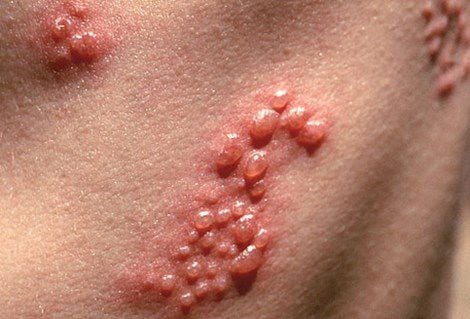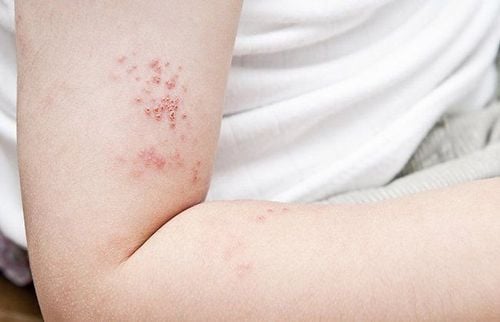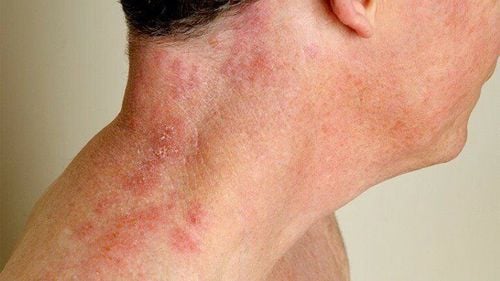This is an automatically translated article.
Shingles on the abdomen and intercostal nerves is a viral disease that attacks mainly the skin of the abdomen and nerves in that area. This is a disease often with sudden onset, acute course, if not treated properly and promptly, it will lead to many serious complications such as destruction of spinal nerve cells, dysfunction of signal transduction from the skin.
1. Causes of shingles
The causative agent of shingles in general and shingles in the abdomen and shingles intercostal nerve in particular is caused by the same virus that causes chickenpox, the varicella-zoster virus, which manifests with the following clinical symptoms: Fever, skin burning pain like a burn at the site of virus invasion and blisters.
2. Clinical symptoms of shingles

Triệu chứng ban đầu của bệnh zona thần kinh là xuất hiện các mụn nước.
2.1. Shingles in the abdomen Respiratory tract infection Symptoms of a respiratory infection such as: Low-grade fever, fatigue, body aches. Pain, burning, stinging like needles or ants biting the shingles area in the abdomen. Pain can be continuous or intermittent, sometimes causing the patient to cry.
Itching Itching makes the patient feel very uncomfortable, and at the same time this area of the skin increases sensitivity, so every time the patient touches the skin, the pain increases.
Appearance of blisters Initially, the shingles skin on the abdomen appears a pink-red patch, then blisters appear. The blisters grow up in clusters close together to form patches or clusters that are linked together.
Some cases of blisters grow consecutively, from time to time, causing a full area of shingles in the abdomen. The shingles blisters on the abdomen are swollen and break easily.
When shingles in the abdomen, after about 1-2 weeks, the disease will go away on its own if there is no superinfection or no complications. In case shingles in the abdomen is superinfected, the patient may have a fever again and a higher fever, the skin on the abdomen with shingles will be at risk of festering and can spread to many other healthy skin areas (skin infection). after shingles) and also very easily lead to the risk of sepsis.
2.2. Shingles intercostal neuralgia Patient feels burning pain in the area of shingles intercostal nerve damage for a while, sometimes lasting for months and often recurring pain.
Shingles intercostal nerve , usually progressing through 2 stages:
2.2.1 Acute stage onset Burning pain in an intercostal patch, after a few days appear red skin Appearance of tiny vesicles with a tendency to spread along the distribution of the intercostal nerve. Itching and burning pain like a burn, very uncomfortable, the patient does not dare to let the damaged area come into contact with clothing or touch the skin. Fever and fatigue accompanied. After about a week, the damage caused by shingles of the intercostal nerve is dry, scaly, and scarred. 2.2.2 Stage of sequelae At this stage, intercostal shingles cause burning pain in the affected area for a while, sometimes lasting for months, especially in the elderly.
3. Things to note when suffering from shingles

Lưu ý không được gãi vào vết zano vì có thể làm gia tăng nguy cơ bị nhiễm khuẩn thứ phát và có thể để lại sẹo
Clean the body, bathe daily, keep the shingles area clean and dry. Wear loose clothing to avoid putting pressure on the wound, causing it to burst and spread. Avoid skin-to-skin contact with people who have a history of chickenpox, are sick, or are immunocompromised. Do not scratch the shingles on the abdomen as this can increase the risk of secondary bacterial infection and possibly scarring. Use a cold compress soaked in cold water to apply ice to the shingles affected area, causing pus oozing lesions about 7, 8 times a day, each time for about 20 minutes to ease the pain and dry the wound. Do not use compression bandages when the skin lesions are dry to prevent the surrounding skin from becoming dry and itchy. Do not treat intercostal neuralgia with folk experiences such as: Apply green beans, glutinous rice or herbal leaves, suck and spray a liquid on the damaged skin surface. The reason is that they can increase the risk of skin superinfection, cause ulcers, skin irritation... Use the right medicine, at the right time as prescribed by the doctor. It is necessary to clean the skin of the shingles in the abdomen and the shingles of the intercostal nerve and use the antiseptic drugs prescribed by the doctor in order not to let the infected skin area become infected with bacteria. Create psychological comfort to avoid unnecessary worries and determination to treat the disease quickly. When you see new symptoms or cannot control the pain or itching of shingles, it is important to see your doctor for prompt treatment. Certain antiviral medications can control symptoms, as well as shorten the duration and severity of illness. These medications are most effective if you start them as soon as possible after the rash appears. You can also take over-the-counter pain relievers or other medications prescribed by your doctor.
If you have unusual symptoms, you should be examined and consulted with a specialist.
Please dial HOTLINE for more information or register for an appointment HERE. Download MyVinmec app to make appointments faster and to manage your bookings easily.













